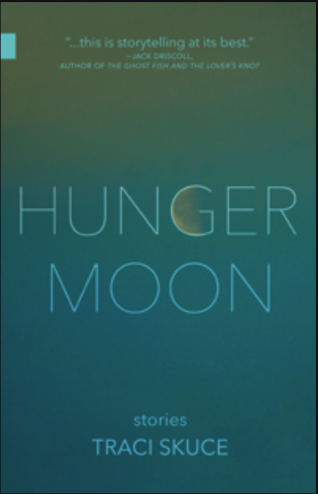 by Skylar Kay
by Skylar Kay
Hunger Moon
by Traci Skuce
NeWest Press (2020)
ISBN 978-1-988732-80-0
Traci Skuce’s Hunger Moon is a well-crafted collection of short stories. While only two of these stories have the same characters, they connect by circling around a central theme: characters finding themselves at a tipping point in their lives and hungering for something more. Whether that something more is an exotic adventure, an escape from a relationship, or the beginning of a new one, the characters in Skuce’s collection all desire to expand another aspect of themselves.
The characters of the short stories are all well-developed — even the ones who aren’t the main focus of the story. I remember reading one story and thinking that the conflict was clearly between two people, but as the story itself develops, I realized that the conflict is internal, as both characters have motivation and reason for their actions, for which the reader cannot fault them. The characters also display a fairly wide range of personalities, showing Skuce’s depth and ability as a storyteller. The initial story is that of a small child, dealing with troubles both at school and at home; this small girl, Heidi, is also the only character arc that appears later in the collection as well. In sharp contrast with Heidi, Skuce creates a compelling character who is a boy in high school, as the titular short story “Hunger Moon” introduces him through the second-person voice. In addition to these voices, Skuce tells stories of university hopefuls who travel to exotic places, or plant trees in British Columbia, and parents who struggle and overcoming the obstacles of being a single parent, or a nearly single parent with an uncooperative partner. Regardless of age, gender, or point of view, Skuce manages to write characters in compelling ways that keep the reader interested and engaged.
Another aspect of these stories which serve to connect them all is setting. Sometimes when authors use real locations, the setting can be too specific, as they name streets, roads, and neighbourhoods which might alienate readers unfamiliar with these areas. Skuce, on the other hand, while grounding the stories mostly in British Columbia, does not do so with a heavy hand, and she still allows the stories to be about the people rather than about the place. The setting is always vividly presented, and it often helps accentuate the characters’ inner turmoil, whether that be the total stillness of a tree-planting camp in the North, or the interior of a dingy apartment which is only periodically filled with silence rather than a baby’s crying.
Other than the skillful presentation of character and setting, Skuce is a brilliant creative writer, as tropes are addressed subtly via images, objects, or events. An example of this writing comes from the story “Kick” when Heidi looks out her window at night and sees three flickering stars after she discusses the relationship of her, her mom, and her sister Laura in the seeming absence of the father/husband.
I could go on listing more of Skuce’s amazing storytelling techniques in Hunger Moon, but honestly, I think you should just read it for yourself. The collection has great stories and is a great read overall.
Skylar Kay is a recent Mount Royal graduate with a degree in English. She is interested in haiku and plans to pursue an M.A in Japanese Literature. She is a prose editor for FreeFall Magazine.
